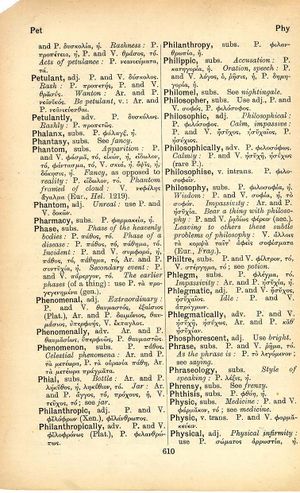phalanx: Difference between revisions
ἀλλ' ἐπὶ καὶ θανάτῳ φάρμακον κάλλιστον ἑᾶς ἀρετᾶς ἅλιξιν εὑρέσθαι σὺν ἄλλοις → even at the price of death, the fairest way to win his own exploits together with his other companions | but even at the risk of death would find the finest elixir of excellence together with his other companions | but to find, together with other young men, the finest remedy — the remedy of one's own valor — even at the risk of death
m (Text replacement - "(|thumb)\n(\|link=)" to "$1$2") |
m (Woodhouse1 replacement) |
||
| Line 1: | Line 1: | ||
{{Woodhouse1 | {{Woodhouse1 | ||
|Text=[[File:woodhouse_610.jpg|thumb|link={{filepath:woodhouse_610.jpg}}]] | |Text=[[File:woodhouse_610.jpg|thumb|link={{filepath:woodhouse_610.jpg}}]] | ||
P. [[φάλαγξ]], ἡ. | ===substantive=== | ||
[[prose|P.]] [[φάλαγξ]], ἡ. | |||
}} | }} | ||
{{Lewis | {{Lewis | ||
Revision as of 09:26, 20 May 2020
English > Greek (Woodhouse)
substantive
Latin > English (Lewis & Short)
phălanx: (post-class. fălanx), angis, f., = φάλαγξ.
I In gen.
A Lit., a band of soldiers, a host drawn up in close order (poet.): Agamemnoniae phalanges, Verg. A. 6, 489: densae, id. ib. 12, 662: Tuscorum, id. ib. 12, 551: animosa (said of eight brothers fighting together), id. ib. 12, 277: junctae umbone phalanges, Juv. 2, 46.—
B Trop., a host, multitude (postclass.): culparum, Prud. Psych. 816.—
II In partic.
A Among the Athenians and Spartans, a division of an army drawn up in battle array, a battalion, phalanx, Nep. Chabr. 1, 2; id. Pelop. 4, 2.—
B The Macedonian order of battle, a Macedonian phalanx (a compact parallelogram of fifty men abreast and sixteen deep), Nep. Eum. 7, 1; Curt. 3, 2, 13; Liv. 31, 39, 10; cf.: quae (cohortes) cuneum Macedonum (phalangem ipsi vocant) perrumperent, id. 32, 17, 11: fecerat et falangem triginta milium hominum, Lampr. Alex. Sev. 50, 5.—
2 An order of battle of the Gauls and Germans, forming a parallelogram: Helvetii confertissimā acie, phalange factā, etc., Caes. B. G. 1, 24; 1, 52: phalangem perfringere, id. ib. 1, 25.
Latin > French (Gaffiot 2016)
phălanx,¹¹ angis, f. (φάλαγξ),
1 phalange [grecque] : Nep. Chabr. 1, 2 ; Pel. 4, 2 || phalange [macédonienne] : Nep. Eum. 7, 1 ; Curt. 3, 2, 13 ; Liv. 31, 39, 10 ; 32, 17, 11 || formation de combat des Gaulois et des Germains : Cæs. G. 1, 24, 5 ; 1, 52
2 [en gén.] troupe, bataillon, armée : Virg. En. 6, 489 ; 12, 662
3 [fig.] foule, grand nombre : Prud. Psych. 816.
Latin > German (Georges)
phalanx (später falanx), angis, f. (φάλαγξ), jede dichtgedrängte Schlachtreihe, Schar, I) eig.: A) im allg., wie die der Trojaner, Verg. Aen. 11, 92: Tuscorum, ibid. 12, 551: phalanges Agamemnoniae, ibid. 6, 489: phalanges stant densae, ibid. 12, 662. – B) insbes.: a) die geschlossenen Glieder des Haupttreffens, bei den Athenern und Spartanern, die Phalanx, Nep. Chabr. 1, 2; Pel. 4, 2. – b) die in einem länglichen Viereck in dicht geschlossenen Reihen, 50 Mann breit und 16 Mann tief, aufgestellte Schlachtordnung (Schlachtreihe) des mazedonischen schweren Fußvolks (zu verschiedenen Zeiten 8–16000 Mann stark), die mazedon. Phalanx (Ggstz. levis armatura), Nep. Eum. 7, 1. Curt. 3, 2 (5), 13 u. ö. Liv. 32, 17, 11 sqq. (wo die ph. latein. cuneus [s. d.] gen. wird): fecerat et falangem triginta milium hominum, Lampr. Alex. Sev. 50, 5. – dah. c) übtr., die von den Römern nach der mazedon. benannte, ein längliches Viereck bildende Schlachtordnung der Gallier und Germanen, bei der die Schilde dicht aneinander geschlossen wurden, phalange factā, in dichtgeschlossenen Gliedern, Caes. b. G. 1, 24, 5 u. 52, 4: hostium phalangem perfringere, ibid. 1, 25, 2. – II) bildl., die dicht gedrängte Schar, -Menge, terrigenae phalanges culparum, Prud. psych. 816.
Latin > English
phalanx phalangis N F :: phalanx, compact body of heavy infantry; battalion; men in battle formation

